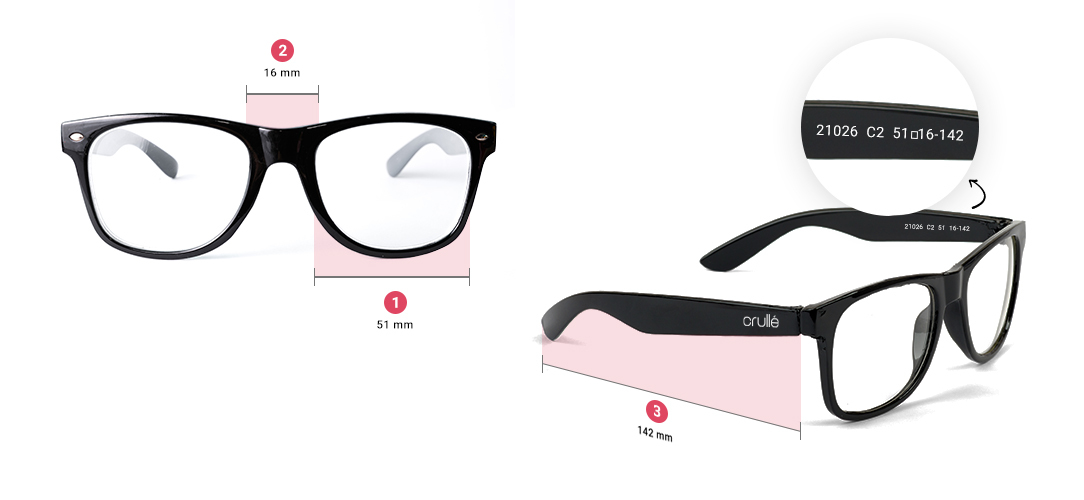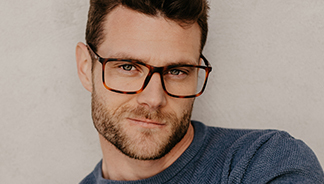The Ultimate Guide to Glasses Frame Size
When it comes to finding the perfect pair of glasses, understanding the frame size is crucial. The numbers inscribed on the side of the frame provide valuable information about its dimensions. This guide will demystify glasses frame sizing, helping you make an informed decision and ensuring your glasses fit comfortably and look stylish.
What Do The Numbers On The Inside Of Glasses' Frames Mean?
The numbers inscribed on the side of the glasses frame hold valuable information about its dimensions. Let's check the common numbers you might encounter!
When you see "51-16-142" on the frame, it may seem like an ordinary number, however the numerical inscription on your glasses frame carries significant information about its dimensions and characteristics:
The first number, 51, represents the lens width in millimeters.
The second number, 16, indicates the bridge width, which is the distance between the lenses.
The third number, 142 denotes the temple length, measuring the arms' length that extends over your ears.
Understanding these measurements is crucial for finding glasses that fit comfortably and suit your face shape.
1 - Lens Width 2 - Bridge Width 3 - Temple Length
Proper Size and Proportions
Glasses Size (S, M, and L)
Glasses come in various sizes, often categorized as small (S), medium (M), and large (L), to accommodate different face shapes and sizes. Finding the right size is essential for both comfort and style. A small size is suitable for narrow faces, ensuring a snug fit that complements delicate features. Medium-sized glasses offer a versatile option that tends to suit a wide range of face shapes. Large frames are designed for broader faces, providing a bold and fashionable look. To help you better understand which size might suit you best, we have included a handy guide below:
- Take a credit card and stand in front of a mirror
- Align the card with the centre of your nose
- The position of the card will determine your size
The card extends past the corner of your eye - S
The card aligns with the corner of your eye - M
The corner of your eye extends past the card - L
How to know if your glasses fit properly?
- The lenses should cover your eyes: After all, what's the point of having glasses if they don't properly cover your eyes? Take a look in the mirror and check if the frame width matches the width of your face, and if the lenses have a curved shape that follows the contour of your eyes. This ensures that the optical lenses provide full coverage and optimal vision.
- The bridge should fit comfortably on your nose: Your glasses' bridge should rest comfortably on the bridge of your nose, neither pinching nor sliding down. A well-fitting bridge provides stability and ensures that the weight of the glasses is evenly distributed. Pay attention to the fit, making sure it feels secure and does not cause any discomfort.
- The temple arms should rest comfortably over your ears: Ensure that the temple arms of your glasses extend straight back and rest comfortably over your ears. They should not apply excessive pressure or cause discomfort. Properly fitting temple arms contribute to the stability of the glasses, preventing them from slipping or sliding down.
- The frames should not obstruct your vision: When wearing your glasses, they should not obstruct your field of vision. The frames should not block your peripheral vision or limit your ability to see clearly in all directions. Check if the frames obstruct your view when looking straight ahead or to the sides. Unobstructed vision is essential for comfortable and functional glasses.
- Consider facial proportions for a balanced look: Take into account your face shape and features when choosing glasses frames. Different face shapes may require specific frame shapes and sizes to achieve a balanced and flattering look. Look for frames that complement your facial proportions, enhancing your appearance and style.
By ensuring that your glasses fit properly, you can enjoy optimal comfort, clear vision, and a flattering look. Take the time to assess the fit using the mirror test and consider consulting with an optician or utilizing virtual try-on tools to find the perfect fit for your glasses.
Tips for Choosing the Right Frame Size
Face Shape:
When selecting glasses, take your face shape into account. Different frame shapes and sizes can complement or enhance certain facial features. For example:
- Round face shape: Angular or geometric frames can add definition and balance.
- Square face shape: Round or oval frames can soften and complement strong jawlines.
- Oval face shape: Most frame shapes work well with oval faces, so you have more flexibility to experiment with different styles.
- Heart-shaped face shape: Frames that are wider at the top or have detailing on the lower portion can balance a narrower chin.
- Diamond-shaped face shape: Frames with gentle curves and oval or cat-eye shapes can accentuate cheekbones.
- Triangle face shape: For this face shape, it's recommended to choose glasses with thinner frames and lots of curves to create contrast.
- Inverted-triangle face shape: When selecting glasses for these face shapes, the goal is to balance out the proportions by drawing attention to the lower part of the face.
You can check our Face shape guide to figure out which shape is yours!
Trying on Frames and Making Adjustments:
- Virtual Try-On: In our online store, we provide a convenient virtual try-on feature that allows you to explore and try on glasses virtually. Using our website, you can upload a photo or utilize your computer or smartphone camera to see how different frames look on your face. This interactive tool enables you to make informed choices before purchasing, providing a virtual experience from the comfort of your own home.
- Visiting an Optician or Eyewear Store: For a precise and accurate fit, we recommend visiting an optician or eyewear store. Our team of experts can assess your facial features, provide professional measurements, and offer personalized recommendations based on your prescription and lifestyle needs. Their guidance ensures that you find frames that fit you perfectly.
Special Considerations
- Prescription Lenses and Frame Size: When selecting glasses frames, it's important to consider your prescription lenses. Depending on your vision correction needs, certain frame sizes and shapes may be more suitable. For example, if you have a higher prescription, you might require frames with larger lenses to accommodate thicker lenses. It's crucial to work with an optician who can help guide you towards frame options that can properly accommodate your prescription. Explore our range of prescription glasses to find the perfect fit for your vision needs.
- Progressive and Bifocal Glasses: If you require progressive or bifocal lenses, it's essential to consider how they will be positioned within the frames. Progressive and bifocal lenses have specific zones for near, intermediate, and distance vision. Therefore, you need frames that have enough vertical space to comfortably fit the different lens segments. Frames with taller lens heights or customizable lens inserts are often recommended for these types of lenses to ensure optimal vision and seamless transitions between focal points.
- Sports Glasses: Different activities may require specialized frames to suit specific needs. For sports enthusiasts, frames designed for athletic activities offer features like impact resistance, wrap-around styles for better peripheral vision, and secure fits to prevent slipping during physical movements. Specialty frames are available for unique requirements such as safety glasses, occupational eyewear, and protective goggles. These frames are designed to meet specific standards and offer enhanced protection and functionality. Browse our collection of sports and specialty frames to find the ideal eyewear for your active lifestyle and specialized needs.


